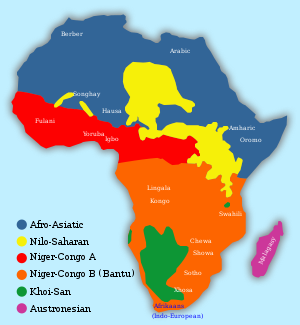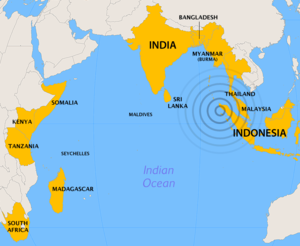User:R4000/Africa(Alt)

Geography
[edit]Main article: Geography of Africa
Africa is the largest continent in the southern hemisphere. It has an estimated area of 30,360,288 km² including the surrounding islands.
Africa is seporated from Europe by the Mediterranean Sea, although it is joined to Asia by the Isthmus of Suez (crossed by the Suez Canel), 130km wide. From the most northern point (Cape Blanc in Tunisia) to the southern point (Cape Agulhas in South Africa) is aproxomatly 8,000 km.
Geographical Facts
[edit]- The largest mountain in Africa is Kilimanjaro, Tanzania. (19,335.6 ft).
- The largest river in Africa is Nile, Egypt. (6,695 km).
- The largest desert in Africa Sahara Desert, crossing Algeria; Libya; Morocco; Western Sahara; Mauritania; Mali; Niger; Chad; Sudan; Eygpt
Languages
[edit]
Main article: African languages
By most estimates Africa contains well over a thousand languages. There are four major language families native to Africa.
- The Afro-Asiatic languages are a language family of about 240 languages.
- The Nilo-Saharan language family consists of more than a hundred languages.
- The Niger-Congo language family covers much of Sub-Saharan Africa and is probably the largest language family in the world in terms of different languages.
- The Khoisan languages number about 50.
With a few notable exceptions in East Africa, nearly all African countries have adopted official languages that originated outside the continent and spread through colonialism or human migration. For example, in numerous countries English and French are used for communication in the public sphere such as government, commerce, education and the media.
Territories
[edit]

| Name of territory, with flag |
Area (km²) |
Population (1 July 2002 est.) |
Population density (per km²) |
Capital |
|---|---|---|---|---|
| Eastern Africa[1]: | ||||
| 27,830 | 6,373,002 | 229.0 | Bujumbura | |
| 2,170 | 614,382 | 283.1 | Moroni | |
| 23,000 | 472,810 | 20.6 | Djibouti | |
| 121,320 | 4,465,651 | 36.8 | Asmara | |
| 1,127,127 | 67,673,031 | 60.0 | Addis Ababa | |
| 582,650 | 31,138,735 | 53.4 | Nairobi | |
| 587,040 | 16,473,477 | 28.1 | Antananarivo | |
| 118,480 | 10,701,824 | 90.3 | Lilongwe | |
| 2,040 | 1,200,206 | 588.3 | Port Louis | |
| 374 | 170,879 | 456.9 | Mamoudzou | |
| 801,590 | 19,607,519 | 24.5 | Maputo | |
| 2,512 | 743,981 | 296.2 | Saint-Denis | |
| 26,338 | 7,398,074 | 280.9 | Kigali | |
| 455 | 80,098 | 176.0 | Victoria | |
| 637,657 | 7,753,310 | 12.2 | Mogadishu | |
| 945,087 | 37,187,939 | 39.3 | Dodoma | |
| 236,040 | 24,699,073 | 104.6 | Kampala | |
| 752,614 | 9,959,037 | 13.2 | Lusaka | |
| 390,580 | 11,376,676 | 29.1 | Harare | |
| Middle Africa: | ||||
| 1,246,700 | 10,593,171 | 8.5 | Luanda | |
| 475,440 | 16,184,748 | 34.0 | Yaoundé | |
| 622,984 | 3,642,739 | 5.8 | Bangui | |
| 1,284,000 | 8,997,237 | 7.0 | N'Djamena | |
| 342,000 | 2,958,448 | 8.7 | Brazzaville | |
| 2,345,410 | 55,225,478 | 23.5 | Kinshasa | |
| 28,051 | 498,144 | 17.8 | Malabo | |
| 267,667 | 1,233,353 | 4.6 | Libreville | |
| 1,001 | 170,372 | 170.2 | São Tomé | |
| Northern Africa: | ||||
| 2,381,740 | 32,277,942 | 13.6 | Algiers | |
| 1,001,450 | 70,712,345 | 70.6 | Cairo | |
| 1,759,540 | 5,368,585 | 3.1 | Tripoli | |
| 446,550 | 31,167,783 | 69.8 | Rabat | |
| 2,505,810 | 37,090,298 | 14.8 | Khartoum | |
| 163,610 | 9,815,644 | 60.0 | Tunis | |
| 266,000 | 256,177 | 1.0 | El Aaiún | |
| Southern Europe dependencies in Northern Africa: | ||||
| 7,492 | 1,694,477 | 226.2 | Las Palmas de Gran Canaria, Santa Cruz de Tenerife | |
| 20 | 71,505 | 3,575.2 | — | |
| 797 | 245,000 | 307.4 | Funchal | |
| 12 | 66,411 | 5,534.2 | — | |
| Southern Africa: | ||||
| 600,370 | 1,591,232 | 2.7 | Gaborone | |
| 30,355 | 2,207,954 | 72.7 | Maseru | |
| 825,418 | 1,820,916 | 2.2 | Windhoek | |
| 1,219,912 | 43,647,658 | 35.8 | Bloemfontein, Cape Town, Pretoria[8] | |
| 17,363 | 1,123,605 | 64.7 | Mbabane | |
| Western Africa: | ||||
| 112,620 | 6,787,625 | 60.3 | Porto-Novo | |
| 274,200 | 12,603,185 | 46.0 | Ouagadougou | |
| 4,033 | 408,760 | 101.4 | Praia | |
| 322,460 | 16,804,784 | 52.1 | Abidjan, Yamoussoukro[9] | |
| 11,300 | 1,455,842 | 128.8 | Banjul | |
| 239,460 | 20,244,154 | 84.5 | Accra | |
| 245,857 | 7,775,065 | 31.6 | Conakry | |
| 36,120 | 1,345,479 | 37.3 | Bissau | |
| 111,370 | 3,288,198 | 29.5 | Monrovia | |
| 1,240,000 | 11,340,480 | 9.1 | Bamako | |
| 1,030,700 | 2,828,858 | 2.7 | Nouakchott | |
| 1,267,000 | 10,639,744 | 8.4 | Niamey | |
| 923,768 | 129,934,911 | 140.7 | Abuja | |
| 410 | 7,317 | 17.8 | Jamestown | |
| 196,190 | 10,589,571 | 54.0 | Dakar | |
| 71,740 | 5,614,743 | 78.3 | Freetown | |
| 56,785 | 5,285,501 | 93.1 | Lomé | |
| Total | 30,368,609 | 843,705,143 | 27.8 | |

- Effect on Somalia
- Villages and coastal communities in Somalia, as far as 4,500 km (2,800 mi) from the epicentre of the earthquake, were swept away and destroyed by the huge waves. 176 people were confirmed dead, 136 were missing and more than 50,000 have been displaced.
- Kenya
- Waves struck Kenya causing some minor damage. One person reported drowned at Watamu, near Mombasa ([10]).
- South Africa
- Casualties: Two reported dead: One boy dead after swimming in the Quinera River at Gonubie, close to East London; an adult dead at Blue Horizon Bay near Port Elizabeth,[11] the furthest point from the epicentre of the earthquake where a tsunami-related death was reported. General observations: Ocean level variance two to three meters outside normal reported in KwaZulu-Natal and Eastern Cape, and a surge of 1.5m was observed as far as Struisbaai in the Western Cape, 8500km from the epicentre of the earthquake. Some steps were taken in South Africa to warn ports and disaster management centres, although full details are not public.[12] Damage: Large concrete blocks were uprooted in East London harbour, where boats also broke from their moorings [13]. Boats and cars were submerged at the Algoa Bay Yacht Club in Port Elizabeth harbour. [14] Durban harbour, Africa's busiest general cargo port and home to the largest and busiest container terminal in the Southern Hemisphere, [15] was closed for some time on 27 December because of unusually strong surges across the entrance channel [16].
- Tanzania
- Ten killed, an unknown number of people missing. Oil tanker temporarily ran aground in Dar es Salaam harbour, damaging an oil pipeline.
- Madagascar
- Flooding in low-lying coastal districts. No reported casualties. Waves reported variously as being between 1.6 and 10 metres in height swept through southeastern coastal areas near the towns of Manakara, Sambava and Vohemar — over 1,000 reported homeless. Problems were exacerbated by the approach of Cyclone Chambo. [17]
HIV Epidemic
[edit]
HIV is most prominent in Southern Africa, where levels are between 15 and 50 percent of the adult population.
| Name of territorys (with flag) with 15-50% HIV adult population |
|---|
